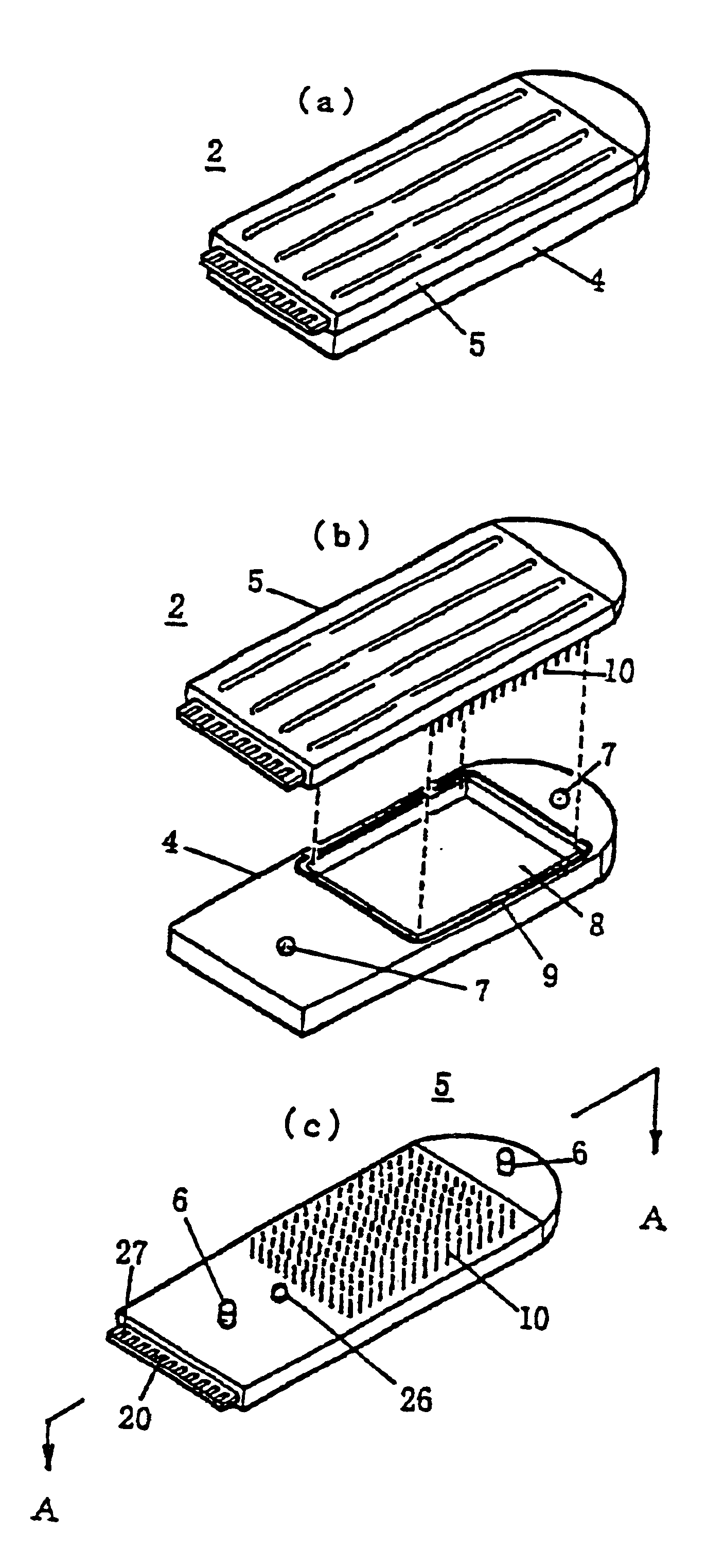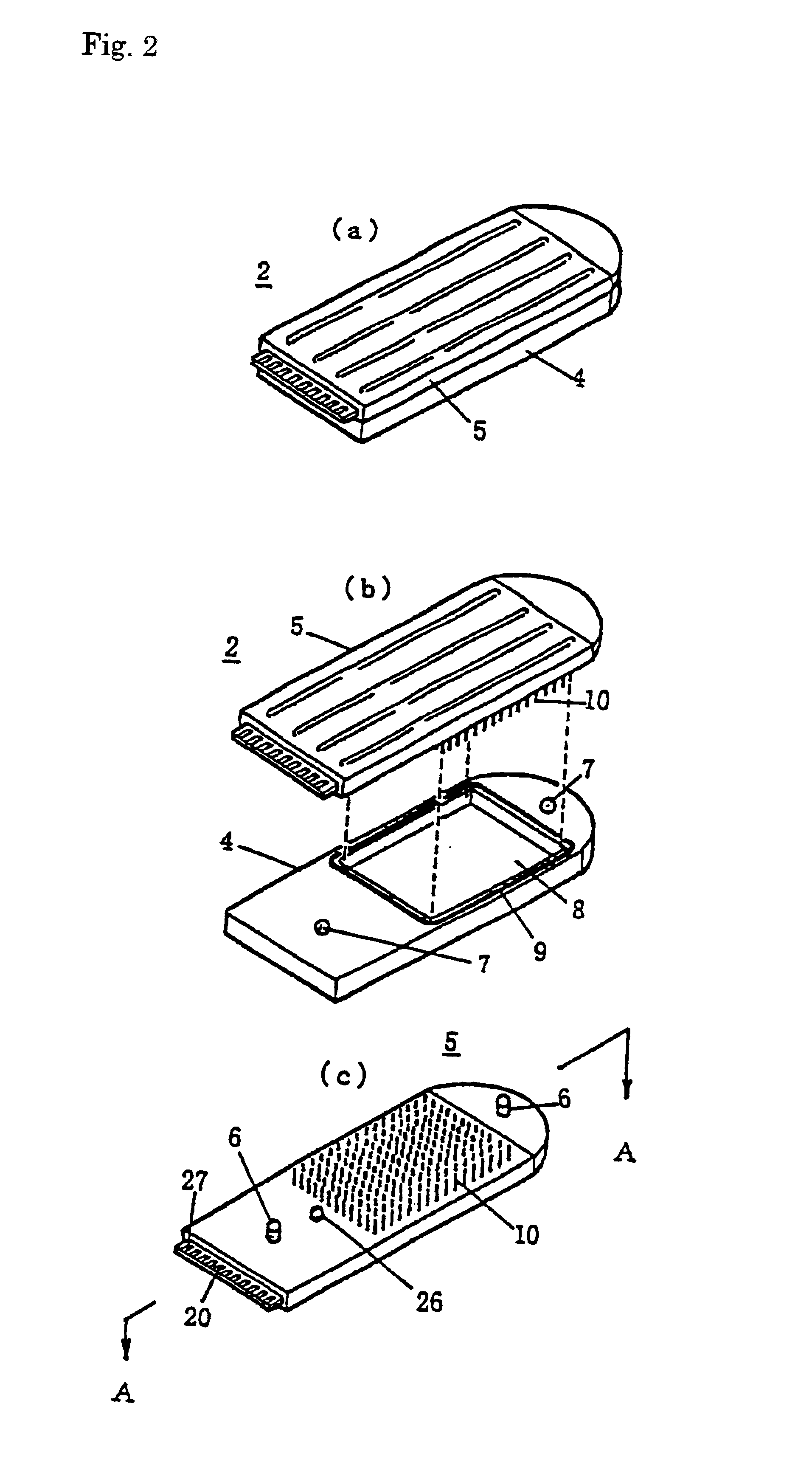Gene detecting chip, detector, and detecting method
- Summary
- Abstract
- Description
- Claims
- Application Information
AI Technical Summary
Benefits of technology
Problems solved by technology
Method used
Image
Examples
experimental example 1
[0108]An experimental example for the detection of a single-base substitution SNP in the 72nd codon of the gene p53 is represented. Oligonucleotides having base sequences corresponding to the two types of polymorphism (genetic polymorphism) were immobilized by spotting respectively to the pin electrodes 10.
[0109]p53Pro (72nd codon whereof is Pro)
[0110]p53Arg (72nd codon whereof is Arg)
[0111]To this, DNA was taken from the peripheral blood of a healthy human wherein the 72nd codon of p53 is Pro and PCR amplified product, wherein the region containing codon 72 exists in the exon 4 of p53 from that DNA, was thermally denatured and then subjected to a hybridization reaction. The variation in the current value before and after hybridization at 470 mV (Ag / AgCl reference electrode standard) at 20 degrees Celsius in the measurement electrolyte solution (0.1M AcOH-AcOK (pH 5.6), 0.1M KCl, 0.05 mM NFc) was measured.
[0112]DNA taken from peripheral blood
[0113]
p53Pro current variation (%)52%p53A...
experimental example 2
[0122]The measured current value differs depending on the number of base substitutions, and an experimental example is described that shows that the mismatch volume can be measured thereby. Seven types of oligonucleotides, namely dT20, dT10dAdT9, dT8dA4dT8, dAdT19, dA3dT17, dT19dA, and dT17dA3, were immobilized by spotting respectively to the pin electrodes 10. As the hybridization counterpart, dA20 was subjected to hybridization reaction.
[0123]The variation in the current values before and after hybridization was measured at 470 mV (Ag / AgCl reference electrode standard) at 20 degrees Celsius in the measurement electrolyte solution (0.1M Ac0H-Ac0K (pH 5.6), 0.1M KCl, 0.05 mM NFc).
[0124]The measurement results are indicated in Table 1
[0125]
TABLE 1Current variation (%)Tm (degrees)
[0126]The current variation in Table 1 is roughly dependent on the number of mismatched bases. In cases where mismatches exist in the end parts, in particular, variation larger than the Tm value was observed....
experimental example 3
[0127]An experimental example for the quantitative measurement of mRNA expression quantities is represented. That wherein a thiol group (HS) was introduced to the end of an oligonucleotide 5′ of a unique sequence 40-mer existing on an LacZ gene on the E. coli lactose operon and this oligonucleotide was immobilized respectively to the pin electrodes 10 (HS-m1: 60 fmol).
[0128]Also, mRNA liquid extract from E. coli containing mRNA of a different expression levels was placed in (a) different well(s) on a titer plate. The previously prepared pin electrodes 10 were immersed into the wells of this titer plate, and a hybridization reaction was conducted under conditions of 2× SSC, room temperature, and 1 hour. [For] this, the variation in the current value before and after hybridization at 470 mV (Ag / AgCl reference electrode standard) at 20 degrees in the measurement electrolyte solution (0.1M AcOH-AcOK (pH 5.6), 0.1M KCl, 0.05 mM NFc) was measured.
[0129]The measurement results obtained are...
PUM
| Property | Measurement | Unit |
|---|---|---|
| Fraction | aaaaa | aaaaa |
| Fraction | aaaaa | aaaaa |
| Temperature | aaaaa | aaaaa |
Abstract
Description
Claims
Application Information
 Login to View More
Login to View More - R&D
- Intellectual Property
- Life Sciences
- Materials
- Tech Scout
- Unparalleled Data Quality
- Higher Quality Content
- 60% Fewer Hallucinations
Browse by: Latest US Patents, China's latest patents, Technical Efficacy Thesaurus, Application Domain, Technology Topic, Popular Technical Reports.
© 2025 PatSnap. All rights reserved.Legal|Privacy policy|Modern Slavery Act Transparency Statement|Sitemap|About US| Contact US: help@patsnap.com



